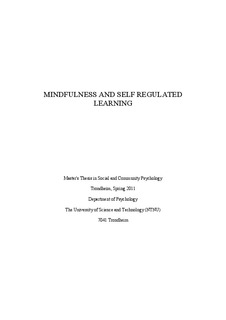| dc.description.abstract | The main purpose of this thesis was to investigate the association between mindfulness and self-regulated learning. Mindfulness is used in the treatment of stress and anxiety, and has been associated with attention regulation and affect-regulation. Mindful individuals have been found to use more strategies to keep attention on task to enhance their performance. It was therefore predicted that mindfulness would be positively associated with self-regulated learning. The data was collected using self-rapport questionnaires and consisted of three different measurements; the Five Facet Mindfulness Questionnaire (FFMQ) [(Baer, R. A., Smith, G. G., Hopkins, J., Krietemeyer, J. & Toney, L. (2006). Using Self-Report Assessment Methods to Explore Facets of Mindfulness. Assessment, 13(1), 27 – 45.)], test anxiety and the strategy section of the “Motivational Strategic Learning Questionnaire” (MSLQ) [(Pintrich, P. R., Smith, D. A. F., Garcia, T., & Mckeachie, W. J. (1991). A Manual for the Use of the Motivated Strategies for Learning Questionnaire (MSLQ). Non-Journal item.)], and a sample from Locke and Latham goal – setting questionnaire. The respondents were 346 students from the “Norwegian University of Science and Technology” (NTNU), with a response rate of 41%. A theoretical link between mindfulness and self-regulated learning is initially introduced, before the empirical investigation. The reliability of the instruments used and dimensional structure was checked to investigate the measurements reliability and consistencies with previous finding. The main aim was then tested, which consisted of testing association between mindfulness and self-regulative learning components, measured as students use of learning strategies, meta-cognitive self-regulation strategies, test anxiety and as goal-setting. Inter-correlations between the indices were performed. Cluster analysis was used to determine response tendencies within the mindfulness dimensions and MANOVA was applied to test differences between the clusters in self-regulated learning. The results indicated that the dimensional structure of the FFMQ was replicated with satisfactory Chronback alpha. Reliability of the learning strategy indices was consistent with previous results. The correlations between the different measurements revealed the facets of mindfulness to be positively correlated with learning strategies, and negatively correlated with test anxiety. Mindfulness was furthermore, across all facets, consistently and significantly positively correlated with goal accomplishment and negatively with goal dissatisfaction. Cluster analysis revealed that the cluster with a combination of high scores on mindfulness facets scored consistently better on the self-regulated learning facets. These results stayed significant even when gender, age and education were controlled for. | nb_NO |
